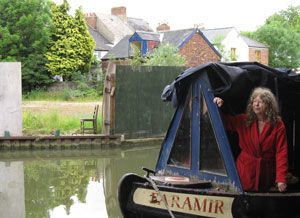JERICHO ECHO ARTICLE
Spring fall opens the way

Canalside future is now in the hands of administrators.
June 2009
The canalside redevelopment saga took another twist in February when Castlemore Securities, owners of Spring Residential, the developer which had bought the site, sank into administration under the weight of debts, which included a loan from HSBC for the £4 million-Jericho site.
For property developers, this is small change. Castlemore had more than a dozen companies, and a ‘development pipeline’ worth more than £1 billion. Its former owner is still worth around £400 million.
Now the canalside site’s future rests with the administrators, PricewaterhouseCoopers (PwC). One key question is whether they will sell Spring’s assets as a single package to another company, such as Berkeley Homes, or will be prepared to accept offers for individual sites. PwC might argue that they are not property managers. Nevertheless they have a duty to maximize the proceeds, which should mean targeting appropriate sites to interested buyers.
In whatever way the Jericho site is to be sold, its value has sunk, along with the rest of the property market, probably to somewhere between £1 million and £2 million. But, as both Bellway Homes and Spring discovered, acquiring the site is the easy part. As soon as they try to pile four-storey blocks of flats on the land they run into fierce and effective opposition, both locally and nationally – and what Spring called a “public relations nightmare.”
For standard ‘volume housebuilders’ this site will be tough going. They will need to carry out a lot of remedial work on contaminated land while also complying with multiple conditions imposed following the two failed planning appeals. The inspector at the first appeal, in 2005, established the requirement of a land contribution for a new community centre, as well as the provision of replacement boatyard facilities, either on the site, or in an “equally accessible location”. The second appeal, in 2008, rejected Spring’s proposed alternative boatyard at Yarnton, while also emphasizing the need for a lively public square – and for sympathetically designed buildings that would respect St. Barnabas Church.
A number of groups have expressed an interest in this site. One is the Jericho Living Heritage Trust (JLHT), a charity, which united with the Jericho Community Association (JCA) to lead the community opposition to Spring at the appeal. The Trust has been raising funds for a community-led development. Stephanie Pirrie for the Trust says: “If we can buy the site we can protect it and preserve as much of the space as possible for community use”. The Trust has been generating a lot of interest, most recently from Stephen Bubb of the Adventure Capital Fund, which backs community enterprises. “Everybody now has to stay strong”, says Stephanie, “and realize that we can do it together. And the more people involved the better – even the smallest things can help”.
Another imaginative non-commercial possibility has also been raised – to have a development based on an eco-centre, along with a boatyard, affordable housing and a community centre. This would involve coming up with a costed plan that would satisfy a financial underwriter.
Commercial developers have also shown an interest. One proposal involves George Ferguson, former President of the Royal Institute of British Architects, who also gave evidence at the appeal against the Spring proposal. On the strength of this, he was approached by Bath-based developer, Future Heritage. Ferguson, says: “This site needs a cultural entrepreneur who will ensure that the community is at the heart of the development, along with enough commercial benefit to enable all this to happen. There should be facilities to take boats out of the water, along with boating-related enterprises. The community centre should not be marginalized, but be at the centre of the development.”
To consider these and other possibilities, four local parties, the JCA, the Church, the Jericho Community Boatyard and the JLHT have formed a Boatyard Coordinating Group.
The JCA has already applied for outline planning permission for a new community centre on the site, to comply with the legal agreement reached with Spring concerning the transfer of land – a commitment which will pass to any new owner. Detailed plans for the centre would be drawn up later after further community consultations.